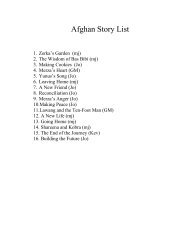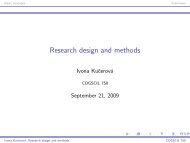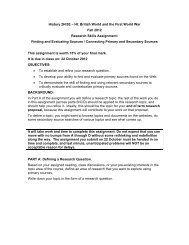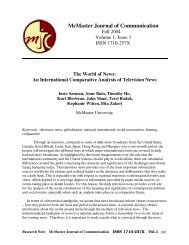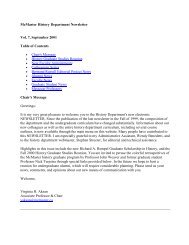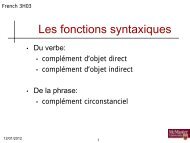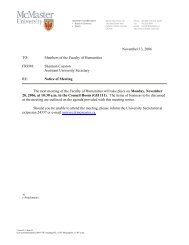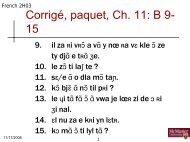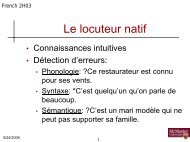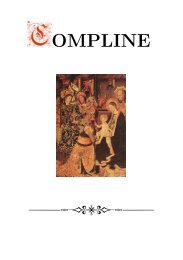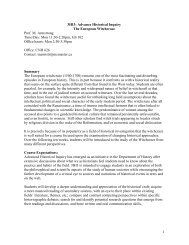3J03 The United States in the 1960s - McMaster University
3J03 The United States in the 1960s - McMaster University
3J03 The United States in the 1960s - McMaster University
Create successful ePaper yourself
Turn your PDF publications into a flip-book with our unique Google optimized e-Paper software.
<strong>McMaster</strong> <strong>University</strong><br />
Course Syllabus<br />
HIS<strong>3J03</strong><br />
<strong>The</strong> <strong>United</strong> <strong>States</strong> <strong>in</strong> <strong>the</strong> <strong>1960s</strong><br />
(Fall 2007)<br />
“Shodd<strong>in</strong>ess can be found easily, <strong>in</strong> quantity. <strong>The</strong> road is smooth<br />
and it lies close by. But <strong>in</strong> front of excellence <strong>the</strong> immortal<br />
gods have put sweat, and long and steep is <strong>the</strong> way out.”<br />
Instructor:<br />
W<strong>in</strong>ston Churchill<br />
Dr. D. Azoulay (CNH 607/C)<br />
Office Hours: Mon. 4:30-6:30, Tues. 3:30-4:30, or by appo<strong>in</strong>tment<br />
Phone: (905)525-9140 ext. 27144<br />
Email: azoulay@mcmaster.ca<br />
Time/Location:<br />
Mon. 3:30, Tues. 4:30, JHE/264<br />
Course Content:<br />
This course will exam<strong>in</strong>e <strong>the</strong> key events, personalities, and ideological<br />
currents of <strong>the</strong> <strong>1960s</strong> <strong>in</strong> America. <strong>The</strong> emphasis will be on social protest,<br />
politics, and foreign policy.<br />
Course Requirements:<br />
<strong>The</strong>re will be two hours of lectures each week, as well as <strong>the</strong> occasional<br />
documentary film. <strong>The</strong>re will be no formal tutorials, but <strong>the</strong> third hour<br />
each week (Thurs. 3:30) will be set aside for an <strong>in</strong>formal “Question and<br />
Answer” session, at which time students may pose questions about <strong>the</strong><br />
lectures, read<strong>in</strong>gs, or assignments. Attendance at this session is optional.<br />
As for written work, students will be asked to submit one “Article Review”<br />
(max. 1200 words) and one Essay (max. 2500 words). <strong>The</strong>re will also be a<br />
two-hour f<strong>in</strong>al exam.<br />
Students will be graded as follows:<br />
Value:<br />
Due:<br />
Article Review: 20% Oct. 1<br />
Essay: 40% Nov. 5<br />
F<strong>in</strong>al Exam: 40% TBA<br />
1
Required Texts:<br />
T. Anderson, <strong>The</strong> Sixties, 3rd edition (Pearson-Longman, 2007)<br />
Email communication:<br />
It is <strong>the</strong> policy of <strong>the</strong> <strong>McMaster</strong> History department that all email<br />
communication between students and <strong>in</strong>structors (<strong>in</strong>clud<strong>in</strong>g TAs) must<br />
orig<strong>in</strong>ate from <strong>the</strong>ir official <strong>McMaster</strong> <strong>University</strong> email accounts. This<br />
policy protects <strong>the</strong> confidentiality and sensitivity of <strong>in</strong>formation and<br />
confirms <strong>the</strong> identities of both <strong>the</strong> student and <strong>in</strong>structor. History<br />
department <strong>in</strong>structors will delete messages that do not orig<strong>in</strong>ate from<br />
<strong>McMaster</strong> email accounts.<br />
LECTURE SCHEDULE AND READINGS<br />
PLEASE NOTE: Audio or visual record<strong>in</strong>gs of <strong>the</strong> course is forbidden<br />
without <strong>the</strong> explicit permission of <strong>the</strong> <strong>in</strong>structor. Lectures are <strong>the</strong><br />
<strong>in</strong>tellectual property of <strong>the</strong> <strong>in</strong>structor.<br />
Week of:<br />
Sept. 3<br />
Sept. 10<br />
READINGS:<br />
QUESTIONS:<br />
Introduction (Thurs)<br />
Roots of <strong>the</strong> Sixties<br />
<strong>The</strong> Sixties, “Introduction”<br />
1. In what ways were <strong>the</strong> 1950s very conformist and conservative?<br />
2. Can we detect <strong>in</strong> <strong>the</strong> 1950s <strong>the</strong> seeds of <strong>1960s</strong>’ phenomena?<br />
Sept. 17<br />
READINGS:<br />
QUESTIONS:<br />
Film: “Seeds of <strong>the</strong> 60s” / Civil Rights Movement:<br />
Orig<strong>in</strong>s and Beg<strong>in</strong>n<strong>in</strong>gs (I)<br />
S. Oates, “Trumpet of Conscience: Mart<strong>in</strong> Lu<strong>the</strong>r K<strong>in</strong>g<br />
Jr.” (ON RESERVE)<br />
1. Why did Mart<strong>in</strong> Lu<strong>the</strong>r K<strong>in</strong>g assume <strong>the</strong> role he did <strong>in</strong> <strong>the</strong> civil<br />
rights struggle?<br />
2. How was he important to <strong>the</strong> movement?<br />
3. How did his views and tactics change by <strong>the</strong> mid-60s?<br />
Sept. 24<br />
Civil Rights Movement: Orig<strong>in</strong>s and Beg<strong>in</strong>n<strong>in</strong>gs(II)/<br />
Film: “No Easy Walk”<br />
READINGS: <strong>The</strong> Sixties, pp. 19-31<br />
QUESTIONS:<br />
2
1. What accounts for <strong>the</strong> spread of <strong>the</strong> civil rights movement <strong>in</strong> <strong>the</strong><br />
early <strong>1960s</strong>?<br />
2. What was <strong>the</strong> significance of JFK’s victory <strong>in</strong> 1960?<br />
3. What impact did <strong>the</strong> violence directed at civil rights activists<br />
have on o<strong>the</strong>r Americans and on <strong>the</strong> Kennedy adm<strong>in</strong>istration?<br />
Oct. 1<br />
JFK: Style over Substance / JFK and <strong>the</strong> World<br />
ARTICLE REVIEW DUE<br />
READINGS: <strong>The</strong> Sixties, pp. 31-44<br />
QUESTIONS:<br />
1. Who or what was to blame for <strong>the</strong> deterioration <strong>in</strong> U.S.-Soviet<br />
relations dur<strong>in</strong>g <strong>the</strong> Kennedy years?<br />
2. What was <strong>the</strong> significance of Birm<strong>in</strong>gham as far as <strong>the</strong> civil rights<br />
movement is concerned?<br />
3. What causes JFK to pursue, by 1963, a more idealistic approach to<br />
domestic and foreign affairs?<br />
Oct. 8<br />
Oct. 9<br />
NO CLASS<br />
LBJ: Substance over Style<br />
READINGS: <strong>The</strong> Sixties, ch. 2<br />
QUESTIONS:<br />
1. Why was 1964 an important year <strong>in</strong> <strong>the</strong> civil rights and student<br />
movements?<br />
2. What were <strong>the</strong> ma<strong>in</strong> grievances of university students <strong>in</strong> <strong>the</strong> early<br />
<strong>1960s</strong>? Were <strong>the</strong>se grievances resolved?<br />
3. In what ways were <strong>the</strong> early <strong>1960s</strong>, especially 1964-65, <strong>the</strong><br />
“p<strong>in</strong>nacle of liberalism”, as Anderson puts it?<br />
Oct. 15<br />
Vietnam<br />
READINGS: J. Clifford, “Vietnam <strong>in</strong> Historical Perspective”;<br />
R. Hammer, “One Morn<strong>in</strong>g <strong>in</strong> <strong>the</strong> War”<br />
QUESTIONS:<br />
1. Why does <strong>the</strong> U.S. take so long to withdraw from Vietnam?<br />
2. What accounts for <strong>the</strong> behaviour of American soldiers at Xom<br />
Lang(and elsewhere)?<br />
Oct. 22<br />
Film: “America <strong>in</strong> Vietnam” / <strong>The</strong> Rise of Black<br />
Militancy<br />
READINGS: <strong>The</strong> Sixties, ch. 3<br />
QUESTIONS:<br />
1. What was so important about <strong>the</strong> Watts riot of 1965?<br />
2. What effect did <strong>the</strong> rise of black power and violence have on <strong>the</strong><br />
3
civil rights movement and on white Americans?<br />
Oct. 29<br />
<strong>The</strong> Youth Rebellion<br />
READINGS: <strong>The</strong> Sixties, ch. 5<br />
QUESTIONS:<br />
1. Why were youth so “alienated” from American society by <strong>the</strong> late<br />
<strong>1960s</strong>?<br />
2. Who were <strong>the</strong> hippies and what did <strong>the</strong>y stand for?<br />
3. Why did <strong>the</strong> counter culture disappear for <strong>the</strong> most part?<br />
Nov. 5<br />
Film: “Break<strong>in</strong>g Boundaries, Test<strong>in</strong>g Limits” / <strong>The</strong><br />
Women’s Movement<br />
ESSAY DUE<br />
READINGS:<br />
QUESTIONS:<br />
S. Evans, “<strong>The</strong> Rebirth of <strong>the</strong> Women’s Movement <strong>in</strong> <strong>the</strong><br />
<strong>1960s</strong>”(ON RESERVE)<br />
1. Why did <strong>the</strong> issue of women’s rights become so prom<strong>in</strong>ent by <strong>the</strong><br />
early ‘60s?<br />
2. How did <strong>the</strong> women’s liberation movement differ from <strong>the</strong> ma<strong>in</strong>stream<br />
women’s movement?<br />
3. What problems plagued <strong>the</strong> movement as a whole?<br />
Nov. 12<br />
1968 / Film: “In a Dark Time”<br />
READINGS: <strong>The</strong> Sixties, ch. 4<br />
QUESTIONS:<br />
1. What impact did <strong>the</strong> assass<strong>in</strong>ations of K<strong>in</strong>g and Kennedy have on<br />
America?<br />
2. What was so important about <strong>the</strong> Columbia <strong>University</strong> strike?<br />
3. What accounts for <strong>the</strong> heightened turbulence of 1968?<br />
Nov. 19<br />
Richard Nixon / Gay and Ethnic Power<br />
READINGS: <strong>The</strong> Sixties, ch. 6<br />
QUESTIONS:<br />
1. What was Nixon’s Vietnam policy, and how did it differ from<br />
Johnson’s?<br />
2. How did social protest change <strong>in</strong> <strong>the</strong> years 1969-70?<br />
3. In what ways were women treated as second-class citizens <strong>in</strong> <strong>the</strong><br />
<strong>1960s</strong>?<br />
4. What were <strong>the</strong> domestic consequences of <strong>the</strong> <strong>in</strong>vasion of Cambodia <strong>in</strong><br />
1970?<br />
Nov. 26 Pop Culture / Legacies of <strong>the</strong> ‘60s<br />
4
READINGS: <strong>The</strong> Sixties, pp. 177-193<br />
QUESTIONS:<br />
1. What factors account for <strong>the</strong> grow<strong>in</strong>g disillusionment of <strong>the</strong> American<br />
public with <strong>the</strong> Nixon adm<strong>in</strong>istration <strong>in</strong> <strong>the</strong> early 70s?<br />
2. Why did support for <strong>the</strong> Vietnam war almost totally disappear by<br />
1971?<br />
3. What sorts of social protest emerged <strong>in</strong> <strong>the</strong> early ‘70s, and were<br />
<strong>the</strong>se movements successful?<br />
FINAL EXAM: TBA<br />
ARTICLE REVIEW<br />
Students will be required to submit an "Article Review"(AR). <strong>The</strong><br />
purpose of <strong>the</strong> AR is to foster critical th<strong>in</strong>k<strong>in</strong>g and analytical skills<br />
<strong>in</strong> relation to <strong>in</strong>terpretive historical literature. Basically, it is an<br />
opportunity for you to evaluate <strong>the</strong> content and merits of a piece of<br />
scholarly literature <strong>in</strong> <strong>the</strong> discipl<strong>in</strong>e.<br />
For this assignment you must write a review of ONE of <strong>the</strong> follow<strong>in</strong>g<br />
articles, all of which are on 2-hour Reserve <strong>in</strong> Mills Library:<br />
T. McKeown, “<strong>The</strong> Cuban Missile Crisis and Politics as Usual” (U.S.<br />
foreign policy)<br />
L. Berman, “Com<strong>in</strong>g to Grips with Lyndon Johnson’s War” (Vietnam)<br />
J. Mayer, “Nixon Rides <strong>the</strong> Backlash to Victory: Racial Politics <strong>in</strong> <strong>the</strong><br />
1968 Presidential Campaign”<br />
See <strong>the</strong> "Brief Guide to Prepar<strong>in</strong>g Article Reviews" below for<br />
<strong>in</strong>formation on how to write an Article Review<br />
Deadl<strong>in</strong>es and Late Penalties:<br />
<strong>The</strong> AR is due Oct. 1st and should not exceed 1200 words <strong>in</strong> length. No<br />
paper <strong>in</strong> excess of this limit will be accepted. Extensions will be<br />
granted <strong>in</strong> exceptional circumstances only and must be requested before<br />
<strong>the</strong> due date. In fairness to those who submit <strong>the</strong>ir essay on time, late<br />
submissions will be penalized at a rate of 5% per day, exclud<strong>in</strong>g<br />
weekends, to a maximum of 40%. PLEASE NOTE: No AR will be accepted<br />
after Oct. 15th.<br />
Brief Guide to Prepar<strong>in</strong>g Article Reviews<br />
Your AR should consist of three ma<strong>in</strong> sections:<br />
a) A brief <strong>in</strong>troduction outl<strong>in</strong><strong>in</strong>g <strong>the</strong> author(s), title, and subject of<br />
<strong>the</strong> article and a summary of <strong>the</strong> <strong>the</strong>sis or ma<strong>in</strong> argument of <strong>the</strong><br />
article.<br />
5
) A central section consist<strong>in</strong>g of <strong>the</strong> ma<strong>in</strong> arguments presented to<br />
support <strong>the</strong> <strong>the</strong>sis, with particular examples.<br />
c) And a critical evaluation or critique of <strong>the</strong> article, also with<br />
examples.<br />
Note: sections a) and b) should constitute no more than 1/2 to 3/4 of<br />
<strong>the</strong> AR.<br />
Th<strong>in</strong>gs to keep <strong>in</strong> m<strong>in</strong>d while read<strong>in</strong>g <strong>the</strong> article and prepar<strong>in</strong>g <strong>the</strong> AR:<br />
a. read<strong>in</strong>g<br />
-to improve your read<strong>in</strong>g efficiency, bear <strong>in</strong> m<strong>in</strong>d <strong>the</strong> follow<strong>in</strong>g po<strong>in</strong>ts.<br />
Most articles will conta<strong>in</strong> all or most of <strong>the</strong> follow<strong>in</strong>g components: an<br />
<strong>in</strong>troduction, a central body, a conclusion, and footnotes/endnotes. <strong>The</strong><br />
<strong>in</strong>troduction usually conta<strong>in</strong>s useful <strong>in</strong>formation about why <strong>the</strong> author<br />
th<strong>in</strong>ks <strong>the</strong> topic is important and what s/he th<strong>in</strong>ks <strong>the</strong> contribution of<br />
<strong>the</strong> article makes to <strong>the</strong> exist<strong>in</strong>g literature on <strong>the</strong> subject. More<br />
important, <strong>the</strong> <strong>in</strong>troduction and conclusion will often tell you what <strong>the</strong><br />
ma<strong>in</strong> argument of <strong>the</strong> article is (i.e. <strong>the</strong> <strong>the</strong>sis). If you read <strong>the</strong><br />
<strong>in</strong>troduction and conclusion first, you will be alert to <strong>the</strong> ma<strong>in</strong><br />
argument and will <strong>the</strong>refore be better able to identify and determ<strong>in</strong>e<br />
<strong>the</strong> strength of <strong>the</strong> support<strong>in</strong>g arguments.<br />
-<strong>the</strong> footnotes/endnotes (if <strong>in</strong>cluded <strong>in</strong> <strong>the</strong> article) will list <strong>the</strong><br />
sources or written/oral evidence on which <strong>the</strong> article is based. <strong>The</strong>se<br />
sources fall <strong>in</strong>to two ma<strong>in</strong> categories: primary sources, which are<br />
orig<strong>in</strong>al documents like letters, diaries, newspapers, statistics, and<br />
government reports written at <strong>the</strong> time of <strong>the</strong> historical event or<br />
phenomenon under discussion, and secondary sources, such as books or<br />
articles written some time after <strong>the</strong> event, usually by o<strong>the</strong>r<br />
historians. When you discuss <strong>the</strong> evidence on which <strong>the</strong> article is<br />
based, you will want to comment on <strong>the</strong> types of sources <strong>the</strong> author uses<br />
and whe<strong>the</strong>r <strong>the</strong>se are sufficient or reliable <strong>in</strong> your view.<br />
b. writ<strong>in</strong>g<br />
-with reference to <strong>the</strong> first two sections of your AR (<strong>the</strong>sis and<br />
support<strong>in</strong>g arguments), ask yourself such questions as "What is <strong>the</strong><br />
author try<strong>in</strong>g to prove to me, <strong>the</strong> reader, <strong>in</strong> this article?" Bear <strong>in</strong><br />
m<strong>in</strong>d that <strong>the</strong> <strong>the</strong>sis may be explicitly or implicitly stated and is<br />
often found <strong>in</strong> <strong>the</strong> <strong>in</strong>troductory or conclud<strong>in</strong>g portions of <strong>the</strong> article.<br />
If, however, <strong>the</strong> author’s <strong>the</strong>sis is not clear, this can be one of your<br />
criticisms.<br />
-with reference to <strong>the</strong> third section of <strong>the</strong> AR (critical evaluation /<br />
critique), ask yourself such general questions as "How well has <strong>the</strong><br />
author proven her/his <strong>the</strong>sis?" and "Is <strong>the</strong> general or ma<strong>in</strong> argument<br />
persuasive?" Here are some of <strong>the</strong> more specific criteria you may wish<br />
to use <strong>in</strong> assess<strong>in</strong>g <strong>the</strong> strengths/weaknesses of <strong>the</strong> article:<br />
6
-how is <strong>the</strong> article organized or structured and does this help or<br />
h<strong>in</strong>der <strong>the</strong> po<strong>in</strong>t(s) <strong>the</strong> author is try<strong>in</strong>g to convey?<br />
-what evidence is presented to prove <strong>the</strong> <strong>the</strong>sis; is it sufficient<br />
and reliable; and can this evidence be <strong>in</strong>terpreted <strong>in</strong> o<strong>the</strong>r ways?<br />
-what k<strong>in</strong>ds of assumptions are made <strong>in</strong> <strong>the</strong> article (if any) and<br />
are <strong>the</strong>y valid?<br />
-has <strong>the</strong> author overstated or understated certa<strong>in</strong> facts, as<br />
far as you know?<br />
-does <strong>the</strong> article conta<strong>in</strong> errors <strong>in</strong> reason<strong>in</strong>g?<br />
-is <strong>the</strong> writ<strong>in</strong>g style effective (is <strong>the</strong> article easy to read?)<br />
(Note: you are not expected to use all of <strong>the</strong>se criteria <strong>in</strong> evaluat<strong>in</strong>g<br />
<strong>the</strong> article, but should address at least some of <strong>the</strong>se questions <strong>in</strong><br />
your critique).<br />
-be sure to <strong>in</strong>dicate both <strong>the</strong> good and bad po<strong>in</strong>ts of <strong>the</strong> article <strong>in</strong><br />
your evaluation.<br />
-remember, too, that although <strong>the</strong> article has been written by a<br />
scholar, it is still open to question<strong>in</strong>g <strong>in</strong> terms of its assumptions,<br />
conclusions, evidence and so on. In o<strong>the</strong>r words, do not be afraid to<br />
challenge po<strong>in</strong>ts on which you may disagree with <strong>the</strong> author, provided<br />
that your criticisms are rational and reasonable.<br />
PLEASE NOTE: we are not look<strong>in</strong>g for a summary of <strong>the</strong> article's<br />
contents, but a careful and clearly written review of its <strong>the</strong>sis and<br />
support<strong>in</strong>g arguments, as well as a thoughtful assessment of <strong>the</strong><br />
article's strengths and weaknesses.<br />
ESSAY<br />
<strong>The</strong> follow<strong>in</strong>g list of essay questions covers most of <strong>the</strong> ma<strong>in</strong> topics <strong>in</strong><br />
<strong>the</strong> course and has been devised to satisfy a wide variety of <strong>in</strong>terests.<br />
More important, <strong>the</strong> topics have been specially chosen to facilitate<br />
<strong>the</strong> primary purpose of <strong>the</strong> essay exercise, which is to present a clear<br />
and well-substantiated argument (i.e. "<strong>in</strong>terpretation") <strong>in</strong> relation to<br />
a specific historic event or process. As such, you must select your<br />
topic from this list.<br />
See <strong>the</strong> "Brief Guide to Essay Preparation" below for <strong>in</strong>formation on how<br />
to write historical essays.<br />
Deadl<strong>in</strong>es and Late Penalties:<br />
<strong>The</strong> essay is due Nov. 5th and should not exceed 2500 words <strong>in</strong> length.<br />
No paper <strong>in</strong> excess of this limit will be accepted. Extensions will be<br />
granted <strong>in</strong> exceptional circumstances only and must be requested before<br />
<strong>the</strong> due date. In fairness to those who submit <strong>the</strong>ir essay on time, late<br />
submissions will be penalized at a rate of 5% per day, exclud<strong>in</strong>g<br />
weekends, to a maximum of 40%. Please note: no essay will be accepted<br />
after Nov. 19th.<br />
7
Appeals:<br />
As far as resubmitt<strong>in</strong>g assignments is concerned, <strong>the</strong> policy <strong>in</strong> this<br />
course is that students will not be allowed to rewrite and resubmit<br />
papers which have already been graded. If, however, students have<br />
concerns about <strong>the</strong>ir graded papers, <strong>the</strong>y are encouraged to first<br />
approach <strong>the</strong> TA who marked <strong>the</strong> paper, and if this fails to br<strong>in</strong>g<br />
satisfaction, should <strong>the</strong>n approach <strong>the</strong> Instructor. <strong>The</strong>re are, as well,<br />
certa<strong>in</strong> formal appeal procedures which may be <strong>in</strong>voked should a student<br />
cont<strong>in</strong>ue to feel that his/her paper has not received <strong>the</strong> consideration<br />
it is due.<br />
Sources:<br />
You will note that certa<strong>in</strong> books have been cited under each essay<br />
topic. It is expected that <strong>the</strong>se will be used <strong>in</strong> research<strong>in</strong>g <strong>the</strong> essay,<br />
if available, <strong>in</strong> addition to o<strong>the</strong>r books, scholarly articles, and if<br />
necessary “primary” materials (i.e. written by participants <strong>in</strong>, or<br />
direct observers of, <strong>the</strong> historical phenomenon <strong>in</strong> question).<br />
For additional sources, see <strong>the</strong> “Additional Read<strong>in</strong>g” section at <strong>the</strong><br />
back of <strong>the</strong> course text. Ano<strong>the</strong>r good research tool is <strong>the</strong> <strong>McMaster</strong><br />
<strong>University</strong> On-l<strong>in</strong>e Library Catalogue, called “Morris”, at<br />
http://morris.mcmaster.ca. From here students can easily search for<br />
books by key word etc., and for scholarly articles by search<strong>in</strong>g <strong>the</strong> E-<br />
Article Databases, such as “America, History and Life.” Overall, at<br />
least 3 books deal<strong>in</strong>g more or less directly with <strong>the</strong> topic should be<br />
used, <strong>in</strong> addition to several scholarly articles and, if necessary,<br />
primary materials.<br />
Note: Internet-based “secondary” sources are f<strong>in</strong>e, as long as <strong>the</strong>y are<br />
written by scholars and documented with footnotes or endnotes;<br />
Internet-based “primary” sources are also acceptable.<br />
However, general survey texts (eg. Garraty’s A Short History of <strong>the</strong><br />
American Nation) as well as <strong>the</strong> course text, are not acceptable as<br />
bibliographic items and should only be used to <strong>in</strong>troduce students to<br />
<strong>the</strong>ir chosen topic or to locate sources. Nor should <strong>the</strong> lectures be<br />
considered a source.<br />
Academic Dishonesty:<br />
Academic dishonesty consists of misrepresentation by deception or by<br />
o<strong>the</strong>r fraudulent means and can result <strong>in</strong> serious consequences, e.g. <strong>the</strong><br />
grade of zero on an assignment, loss of credit with a notation on <strong>the</strong><br />
transcript (notation reads: “Grade of F assigned for academic<br />
dishonesty”), and/or suspension or expulsion from <strong>the</strong> university.<br />
It is your responsibility to understand what constitutes academic<br />
dishonesty. For <strong>in</strong>formation on <strong>the</strong> various k<strong>in</strong>ds of academic dishonesty<br />
please refer to <strong>the</strong> Academic Integrity Policy, specifically Appendix 3,<br />
located at http://www.mcmaster.ca/univsec/policy/AcademicIntegrity.pdf<br />
8
<strong>The</strong> follow<strong>in</strong>g illustrates only three forms of academic dishonesty:<br />
1. Plagiarism, e.g. <strong>the</strong> submission of work that is not one’s own or<br />
for which o<strong>the</strong>r credit has been obta<strong>in</strong>ed.<br />
2. Improper collaboration <strong>in</strong> group work<br />
3. Copy<strong>in</strong>g or us<strong>in</strong>g unauthorized aids <strong>in</strong> tests and exam<strong>in</strong>ations.<br />
In this course we will be us<strong>in</strong>g software (eg. turnit<strong>in</strong>.com) designed to<br />
reveal plagiarism. Students are <strong>the</strong>refore required to submit an<br />
electronic version of <strong>the</strong>ir essay (ei<strong>the</strong>r by email or on disk) as well<br />
as a hard copy <strong>in</strong> class. Failure to do so will result <strong>in</strong> a mark of zero<br />
on <strong>the</strong> essay. Students may also be asked to submit <strong>the</strong>ir research notes<br />
and rough drafts or to defend <strong>the</strong>ir papers orally. Failure to provide<br />
such notes on request may result <strong>in</strong> an "F" grade on <strong>the</strong> essay.<br />
Essay Questions:<br />
1. Why did <strong>the</strong> Kennedy adm<strong>in</strong>istration <strong>in</strong>troduce <strong>the</strong> “Peace Corps,” and<br />
why did so many young people volunteer to serve <strong>in</strong> it?<br />
F. Fischer, Mak<strong>in</strong>g <strong>The</strong>m Like Us<br />
M. Latham, Modernization as Ideology<br />
D. Burner, John F. Kennedy and a New Generation<br />
2. Discuss <strong>the</strong> significance of <strong>the</strong> 1960 Greensboro “sit-<strong>in</strong>” to <strong>the</strong><br />
black civil rights movement.<br />
M. Wolff, Lunch at <strong>the</strong> Five and Ten<br />
W. Chafe, Civilities and Civil Rights<br />
C. Carson, In Struggle<br />
3. Why did “poverty” become such an important issue to Americans <strong>in</strong> <strong>the</strong><br />
<strong>1960s</strong>, a time of unprecedented prosperity?<br />
M. Katz, In <strong>the</strong> Shadow of <strong>the</strong> Poorhouse<br />
J. Patterson, America’s Struggle Aga<strong>in</strong>st Poverty<br />
M. Harr<strong>in</strong>gton, Fragments of a Century<br />
4. Discuss <strong>the</strong> <strong>in</strong>fluence of Rachel Carson’s 1962 book, Silent Spr<strong>in</strong>g,<br />
on America.<br />
T. Dunlap, DDT<br />
S. Hays, Beauty, Health and Permanence<br />
K. Sale, <strong>The</strong> Green Revolution<br />
R. Nash, <strong>The</strong> Rights of Nature<br />
5. What stra<strong>in</strong>s did <strong>the</strong> <strong>1960s</strong> youth rebellion, <strong>in</strong> all its forms, br<strong>in</strong>g<br />
to American families?<br />
T. Powers, <strong>The</strong> War at Home<br />
T. Wells, <strong>The</strong> War With<strong>in</strong><br />
R. Hansel, Like Fa<strong>the</strong>r, Like Son, Like Hell<br />
9
6. Discuss <strong>the</strong> most important legal ga<strong>in</strong>s made by women <strong>in</strong> <strong>the</strong> <strong>1960s</strong><br />
and early ‘70s <strong>in</strong> <strong>the</strong>ir struggle for equality.<br />
W. Chafe, Women and Equality<br />
F. Davis, Mov<strong>in</strong>g <strong>the</strong> Mounta<strong>in</strong><br />
R. Rosen, <strong>The</strong> World Split Open<br />
7. Aside from <strong>the</strong> immediate destruction <strong>the</strong>y caused, what effect did<br />
<strong>the</strong> ghetto riots of <strong>the</strong> late <strong>1960s</strong> have on <strong>the</strong> civil rights movement<br />
and on America generally?<br />
H. Sitkoff, <strong>The</strong> Struggle for Black Equality (selected chapters)<br />
R. Fogelson, Violence as Protest<br />
J. Feag<strong>in</strong>, Ghetto Revolts<br />
J. Button, Black Violence<br />
8. Describe <strong>the</strong> 1967 “Human Be-In” <strong>in</strong> San Francisco, and more<br />
importantly, <strong>the</strong> significance or mean<strong>in</strong>g of what transpired at this<br />
event.<br />
C. Perry, <strong>The</strong> Haight-Ashbury<br />
E. Morgan, <strong>The</strong> 60s Experience<br />
D. Chalmers, And <strong>the</strong> Crooked Places Made Straight<br />
9. Did <strong>the</strong> power and status (i.e. rights, treatment, image, etc.) of<br />
Hispanic-Americans change much <strong>in</strong> <strong>the</strong> period 1960 to 1975<br />
approximately?<br />
F. Rosales, Chicano!<br />
L. H. Gann, <strong>The</strong> Hispanics <strong>in</strong> <strong>the</strong> <strong>United</strong> <strong>States</strong><br />
C. Munoz, Youth, Identity, Power<br />
10. Were <strong>the</strong> 1970 Kent State kill<strong>in</strong>gs unnecessary, or did <strong>the</strong> student<br />
protestors br<strong>in</strong>g <strong>the</strong> violence upon <strong>the</strong>mselves?<br />
J. Kelner, <strong>The</strong> Kent State Coverup<br />
J. Eszterhas, Thirteen Seconds<br />
I. F. Stone, <strong>The</strong> Kill<strong>in</strong>gs at Kent<br />
Brief Guide to Essay Preparation<br />
A number of very good essay-writ<strong>in</strong>g manuals are available for purchase<br />
or <strong>in</strong> <strong>the</strong> library (listed below) and students who have any doubts about<br />
<strong>the</strong>ir essay-writ<strong>in</strong>g ability or wish to improve <strong>the</strong>ir skills <strong>in</strong><br />
particular areas are strongly encouraged to ei<strong>the</strong>r consult <strong>the</strong>se<br />
manuals, your TA, or <strong>the</strong> course <strong>in</strong>structor, or to visit <strong>the</strong> Centre for<br />
Student Development’s Writ<strong>in</strong>g Cl<strong>in</strong>ic<br />
(http://csd.mcmaster.ca/academic/writ<strong>in</strong>g_skills.htm).<br />
Here are some useful tips (from York <strong>University</strong>'s Essay Tutor<strong>in</strong>g<br />
Centre) for writ<strong>in</strong>g and revis<strong>in</strong>g drafts of your essay:<br />
10
"1. Does your essay fall with<strong>in</strong> <strong>the</strong> terms of <strong>the</strong> assignment. Is t on<br />
topic? Does it answer <strong>the</strong> question? Have you correctly INTERPRETED THE<br />
ASSIGNMENT?<br />
2. Does your essay have a clear and explicitly stated THESIS, that is,<br />
a clearly stated central idea that <strong>the</strong> rest of <strong>the</strong> essay develops and<br />
supports?<br />
3. Is <strong>the</strong>re a broad enough base of <strong>in</strong>formation? Is <strong>the</strong> evidence <strong>in</strong> <strong>the</strong><br />
essay that you have done appropriate and sufficient....<br />
4. Is your essay argumentative? Is <strong>the</strong>re a body of ARGUMENT presented<br />
<strong>in</strong> a way that supports <strong>the</strong> <strong>the</strong>sis? Have you given good reasons for your<br />
<strong>the</strong>sis?<br />
5. Are your arguments supported by appropriate and sufficient EVIDENCE?<br />
6. Does your writ<strong>in</strong>g show a reasonable sense of paragraph structure? Is<br />
<strong>the</strong> topic of each paragraph clear and is that topic clearly related to<br />
prov<strong>in</strong>g <strong>the</strong> <strong>the</strong>sis?<br />
7. Is it clear how <strong>the</strong> evidence supports <strong>the</strong> argument? Are quotations<br />
<strong>in</strong>troduced <strong>in</strong> a way that makes <strong>the</strong>ir function <strong>in</strong> <strong>the</strong> argument clear? Do<br />
you comment on quotations <strong>in</strong> a way which shows <strong>the</strong>ir relevance to <strong>the</strong><br />
<strong>the</strong>sis?<br />
8. Is <strong>the</strong> sentence level grammar correct? For example, do verbs agree<br />
with <strong>the</strong>ir subjects; are tense sequences correct, and do pronouns have<br />
antecedents?<br />
9. Is <strong>the</strong>re coherence from sentence to sentence and a reasonable<br />
transition from paragraph to paragraph?<br />
10. Do you follow appropriate conventions of documentation, footnot<strong>in</strong>g,<br />
and bibliography? (note: for HIS<strong>3J03</strong>, and most humanities courses, <strong>the</strong><br />
appropriate documentation style is cited <strong>in</strong> K. Turabian's A Manual For<br />
Writers of Term Papers, <strong>The</strong>ses, and Dissertations)<br />
11. Could o<strong>the</strong>r aspects of your writ<strong>in</strong>g be improved?"<br />
<strong>The</strong>se are useful questions which students should ask <strong>the</strong>mselves while<br />
prepar<strong>in</strong>g <strong>the</strong>ir essays. In addition, students will want to keep <strong>the</strong><br />
follow<strong>in</strong>g essay-writ<strong>in</strong>g h<strong>in</strong>ts <strong>in</strong> m<strong>in</strong>d, as <strong>the</strong>y will be important<br />
criteria used by <strong>the</strong> TA <strong>in</strong> grad<strong>in</strong>g <strong>the</strong> essay:<br />
Content:<br />
a) <strong>The</strong>sis: make sure to state this clearly and forcefully <strong>in</strong> your<br />
<strong>in</strong>troduction (and re-state it <strong>in</strong> your conclusion), and to repeat it<br />
occasionally <strong>in</strong> <strong>the</strong> body of <strong>the</strong> paper, whenever evidence is presented<br />
<strong>in</strong> support of <strong>the</strong> <strong>the</strong>sis. Remember, an essay is not a simple narrative<br />
of events, such as found <strong>in</strong> general survey textbooks, but a focussed<br />
11
argument <strong>in</strong> support of a particular po<strong>in</strong>t of view or <strong>in</strong>terpretation.<br />
b) Evidence: make sure you have sufficient evidence, <strong>in</strong> <strong>the</strong> form of<br />
examples and footnotes/endnotes, to prove your <strong>the</strong>sis. Remember that<br />
you are build<strong>in</strong>g a case, as <strong>in</strong> a court of law, and that your task is to<br />
marshal as much persuasive evidence as possible <strong>in</strong> support of your<br />
position. This does not mean start<strong>in</strong>g with a <strong>the</strong>sis and <strong>the</strong>n search<strong>in</strong>g<br />
for <strong>the</strong> evidence to prove it. It means tak<strong>in</strong>g a position based on prior<br />
extensive research (compell<strong>in</strong>g arguments cannot be based on<br />
<strong>in</strong>sufficient research) and <strong>the</strong>n br<strong>in</strong>g<strong>in</strong>g forward <strong>the</strong> evidence which<br />
helped persuade you to adopt a particular position or <strong>in</strong>terpretation.<br />
Remember, too, that your <strong>the</strong>sis or position need not be "black" or<br />
"white"--nor will it likely be--but should <strong>in</strong> any case be stated<br />
clearly.<br />
c) Relevancy: avoid discuss<strong>in</strong>g irrelevant th<strong>in</strong>gs or spend<strong>in</strong>g too much<br />
time on po<strong>in</strong>ts which only marg<strong>in</strong>ally relate to your <strong>the</strong>sis.<br />
Form / Style:<br />
a) Clarity: it is important that you convey to <strong>the</strong> reader exactly what<br />
it is you are try<strong>in</strong>g to say. This means us<strong>in</strong>g simple, precise language,<br />
properly def<strong>in</strong><strong>in</strong>g terms and concepts, and avoid<strong>in</strong>g ambiguity. Never<br />
assume <strong>the</strong> reader knows what you mean. It is always better to<br />
over-expla<strong>in</strong>, even at <strong>the</strong> risk of be<strong>in</strong>g repetitive, than to leave <strong>the</strong><br />
reader wonder<strong>in</strong>g what it is you mean to say. One last po<strong>in</strong>t, this<br />
regard<strong>in</strong>g quotations: do not rely on quotes to make your salient po<strong>in</strong>ts<br />
for you. Use quotes spar<strong>in</strong>gly, and only to illustrate your po<strong>in</strong>ts.<br />
b) Organization: this, too, is an important aspect of <strong>the</strong> paper. In <strong>the</strong><br />
<strong>in</strong>troduction, a sort of bluepr<strong>in</strong>t for <strong>the</strong> essay, you will be tell<strong>in</strong>g<br />
<strong>the</strong> reader, ei<strong>the</strong>r implicitly (as part of your <strong>the</strong>sis statement), or<br />
explicitly, how your paper will be organized--<strong>in</strong> what order your po<strong>in</strong>ts<br />
/ support<strong>in</strong>g arguments will be discussed. It is up to you to follow<br />
this order of po<strong>in</strong>ts / arguments <strong>in</strong> <strong>the</strong> body of <strong>the</strong> paper. Preferably<br />
<strong>the</strong>se po<strong>in</strong>ts will be organized <strong>in</strong> some logical fashion. Students should<br />
especially avoid mix<strong>in</strong>g a number of different po<strong>in</strong>ts with<strong>in</strong> <strong>the</strong> same<br />
paragraph or, conversely, distribut<strong>in</strong>g <strong>in</strong> various sections of <strong>the</strong> paper<br />
po<strong>in</strong>ts which should be kept toge<strong>the</strong>r, <strong>in</strong> <strong>the</strong> same section or paragraph.<br />
In short, you should deal with one po<strong>in</strong>t at a time. Follow<strong>in</strong>g this<br />
advice will add greater coherence, clarity, and <strong>the</strong>refore force, to<br />
your argument.<br />
c) Concision: say what you have to say <strong>in</strong> as few words as possible,<br />
without sacrific<strong>in</strong>g mean<strong>in</strong>g. This means, for example, avoid<strong>in</strong>g<br />
repetition and long-w<strong>in</strong>ded sentences(see how concisely I said that?).<br />
d) PLAGIARISM: UNDERSTAND WHAT THIS MEANS! As plagiarism is a very<br />
serious academic offence, one which br<strong>in</strong>gs disrepute both to students<br />
and to <strong>the</strong> university itself, and which carries with it serious<br />
penalties, students are strongly encouraged to read <strong>the</strong> university's<br />
policy on plagiarism and to approach <strong>the</strong> <strong>in</strong>structor with any questions<br />
<strong>the</strong>y might have on this subject.<br />
12
For those who want more <strong>in</strong>formation on essay preparation, <strong>the</strong> follow<strong>in</strong>g<br />
guides/manuals are highly recommended:<br />
M. Hellstern, et. al., <strong>The</strong> History Student Writer’s Manual<br />
R. Marius, A Short Guide to Writ<strong>in</strong>g About History.<br />
Janet Giltrow, Academic Writ<strong>in</strong>g.<br />
Sheridan Baker, <strong>The</strong> Practical Stylist.<br />
Kate Turabian, Student's Guide For Writ<strong>in</strong>g College Papers<br />
Kate Turabian, A Manual for Writers of Term Papers, <strong>The</strong>ses, and<br />
Dissertations.<br />
William Z<strong>in</strong>sser, On Writ<strong>in</strong>g Well.<br />
13




